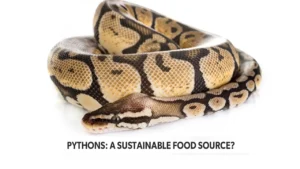
Python on the Menu
min read
Christina Thompson (Anchor, EarthxNews): Scientists are exploring what sources of meat could serve as more sustainable alternatives to beef, pork, and chicken. And, according to a recent study, python farming could be the answer. The latest research suggests the scaly reptiles may offer a way to produce a source of protein with a relatively small environmental footprint. So, could eating snake be what’s for dinner in the future? Joining us now to discuss is Dr. Patrick Aust, director of the African Institute of Applied Herpetology. Thank you for coming on. So eating pythons—is it really more sustainable than something like chicken?
Dr. Patrick Aust: Yeah, apparently so. Certainly according to our research, it seems like their food conversion efficiencies and particularly their protein conversion efficiencies are far more efficient than similar sized, you know, conventional livestock species like chickens and pigs.
Thompson: Well in a whole, in recent years we’ve seen the supply chain got a little bit out of whack from here or there; do pythons fare well with supply chains, um, being impacted by something like extreme weather?
Aust: Yeah absolutely, and that was one of the other interesting things that came out of our study and that is the ability for these animals not only to to live and grow on very little food, but also to survive extremely long periods of time with no food at all and without losing much body mass at all. In fact, they’re very, very good at shutting down their physiology, their biology, and surviving for up to a year literally with no food and very little water. And of course, these are traits that one looks for when when you’re trying to find livestock species that can cope with with an increasing frequency of extreme weather events, droughts, so on and so forth.
Thompson: Is anyone farming pythons in the world right now?
Aust: Yeah, absolutely. It’s certainly not very common, and certainly not in the west; but in southeast Asia there are a lot of farmers that have now turned to python farming partly because they have this competitive edge in very challenging landscapes. And when we talk about extreme weather events, it’s not so much a case of extreme weather events in Southeast Asia—although they do play a part—but it’s actually, it’s increasingly frequency of pandemics particularly swine and bird flu that are wreaking havoc in the poultry and pork industries. And so a lot of these farmers have thrown in the towl, and they’ve now opted to farm pythons.
Thompson: Hypothetically, say we all just start eating snakes for dinner now. How would it help the environment?
Aust: It’s a fairly long list to be brutally honest with you, but I think you know…first and foremost, it’s just we need far less resources to grow that protein than we require. Of course, you know, then there’s other advantages like their ability to to survive–to tolerate extreme weather events, shutdowns and supply chains, to act as a biological barrier to zoonotic diseases. They also have these attributes like the ability to be farmed on the vertical plane because they partially are boreal, they live in trees and underground. Farmers have realized that unlike chickens and pigs, which effectively you have to farm on a a two-dimensional plane, with pythons, they can move up and down. So you can farm them in very small areas.
Thompson: How might a snake even be prepared for the table?
Aust: Lots of different ways. It’s a culinary delicacy throughout much of Asia, and, you know, it can be cooked and prepared in any number of ways and spiced up in any number of ways.
Thompson: Listen, I haven’t had python yet, but I have actually tried rattlesnake in Arizona, and I did think that it tasted a little bit like chicken. If no one had told me it was snake, I wouldn’t have known. Do you think that might start to become more acceptable in the west to eat snakes?
Aust: Yeah, I think, you know, certainly when looking for those competitive advantages. The other–the other thing they offer is, is a nice big white juicy filet–boneless filet. But certainly when it comes to the culinary aspect, I think they lend themselves to a lot of western cuisine.
Thompson: Dr. Patrick Aust, thank you! I’m sure a lot of foodies will enjoy this conversation.
Aust: Thank you very much for having me.
